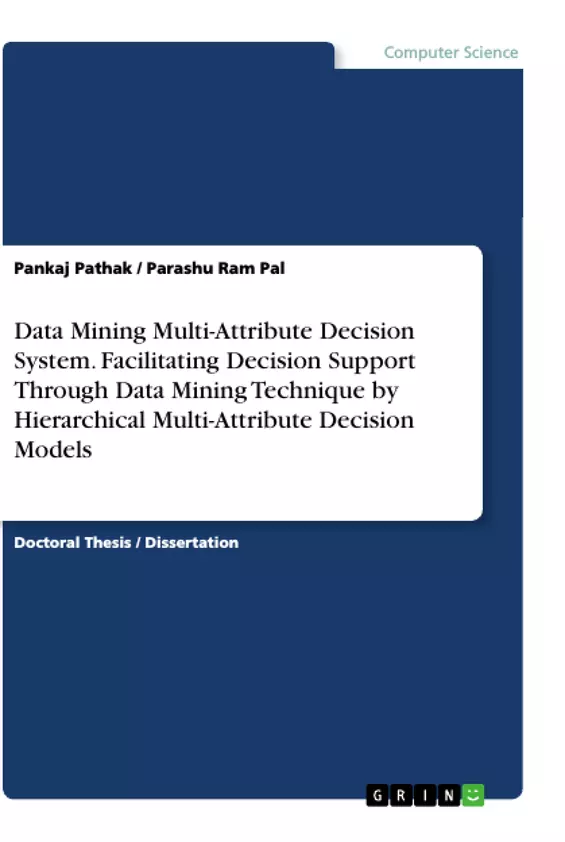Data mining is coined one of the steps while discovering insights from large amounts of data which may be stored in databases, data warehouses, or in other information repositories. Data mining is now playing a significant role in seeking a decision support to draw higher profits by the modern business world. Various researchers studied the benefits of data mining processes and its adoption by business organizations, but very few of them have discussed the success factors of decision support projects.
The Research Hypothesis states the involvement of the decision tree while adopting accuracy of classification and while emphasizing the impact factor or importance of the attributes rather than the information gain. The concept of involvement of impact factor rather than just accuracy can be utilized in developing the new algorithm whose performance improves over the existing algorithms. We proposed a new algorithm which improves accuracy and contributing effectively in decision tree learning. We presented an algorithm that resolves the above stated problem of confliction of class. We have introduced the impact factor and classified impact factor to resolve the conflict situation. We have used data mining technique in facilitating the decision support with improved performance over its existing companion. We have also addressed the unique problem which have not been addressed before. Definitely, the fusion of data mining and decision support can contribute to problem-solving by enabling the vast hidden knowledge from data and knowledge received from experts.
We have discussed a lot of work done in the field of decision support and hierarchical multi-attribute decision models. Ample amount of algorithms are available which are used to classify the data in datasets. Most algorithms use the concept of information gain for classification purpose. Some Lacking areas also exist. There is a need for an ideal algorithm for large datasets. There is a need for handling the missing values. There is a need for removing attribute bias towards choosing a random class when a conflict occurs. There is a need for decision support model which takes the advantages of hierarchical multi-attribute classification algorithms.
Inhaltsverzeichnis (Table of Contents)
- Chapter 1. Introduction to Data Mining and Decision Support
- 1.1 Introduction
- 1.2 The KDD Process
- 1.2.1 Developing and understanding of the application domain
- 1.2.2 Selecting and creating a data set
- 1.2.3 Pre-processing and cleansing
- 1.2.4 Data transformation
- 1.2.5 Choosing the appropriate Data Mining task
- 1.2.6 Choosing the Data Mining algorithm
- 1.2.7 Employing the Data Mining algorithm
- 1.2.8 Evaluation
- 1.2.9 Using the discovered knowledge
- 1.3 The Data Mining, a Step of the KDD Process
- 1.3.1 Database, Data Warehouse, or Other Information Repositories
- 1.3.2 Database or Data Warehouse Server
- 1.3.3 Knowledge Base
- 1.3.4 Data Mining Engine
- 1.3.5 Pattern Evaluation Module
- 1.3.6 Graphical User Interface
- 1.4. Data Mining Functionalities
- 1.4.1 Concept / Class Description: Characterization and Discrimination
- 1.4.2 Association Rule Mining
- 1.4.3 Classification and Prediction
Zielsetzung und Themenschwerpunkte (Objectives and Key Themes)
This book aims to provide a comprehensive guide to the application of data mining techniques for facilitating decision support, focusing on the use of hierarchical multi-attribute decision models. The book explores the various aspects of data mining and decision support systems, including the KDD process, data mining functionalities, and the integration of multi-attribute decision models.
- Data Mining Techniques
- Decision Support Systems
- Hierarchical Multi-Attribute Decision Models
- KDD Process
- Data Mining Functionalities
Zusammenfassung der Kapitel (Chapter Summaries)
Chapter 1 provides an introduction to data mining and decision support systems, exploring the KDD process, data mining functionalities, and the role of multi-attribute decision models. The chapter covers the different stages involved in the KDD process, including data selection, data transformation, algorithm selection, and evaluation. It also discusses various data mining functionalities, such as classification, prediction, and association rule mining. The chapter concludes by highlighting the importance of data mining in today's data-driven world and its role in enhancing decision-making.
Schlüsselwörter (Keywords)
Data mining, decision support, multi-attribute decision models, hierarchical models, KDD process, data transformation, algorithm selection, classification, prediction, association rule mining.
- Citar trabajo
- Dr. Pankaj Pathak (Autor), Dr. Parashu Ram Pal (Autor), 2020, Data Mining Multi-Attribute Decision System. Facilitating Decision Support Through Data Mining Technique by Hierarchical Multi-Attribute Decision Models, Múnich, GRIN Verlag, https://www.grin.com/document/950605



